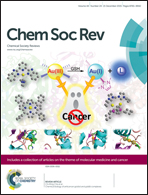Ferrocifen type anti cancer drugs†
Abstract
Despite current developments in therapeutics focusing on biotechnologically-oriented species, the unflagging utility of small molecules or peptides in medicine is still producing strong results. In 2014 for example, of the 41 new medicines authorized for sale, 33 belonged to the category of small molecules, while in 2013 they represented 24 of 27, according to the FDA. This can be explained as the result of recent forays into new or long-neglected areas of chemistry. Medicinal organometallic chemistry can provide us with an antimalarial against resistant parasitic strains, as attested by the phase II clinical development of ferroquine, with a new framework for conceptual advances based on three-dimensional space-filling, and with redox or indeed catalytic intracellular properties. In this context, bioferrocene species with antiproliferative potential have for several years been the subject of sustained effort, based on some initial successes and on the nature of ferrocene as a stable aromatic, with low toxicity, low cost, and possessing reversible redox properties. We show here the different antitumoral approaches offered by ferrocifen derivatives, originally simple derivatives of tamoxifen, which over the course of their development have proved to possess remarkable structural and mechanistic diversity. These entities act via various targets, some of which have been identified, that are triggered according to the concentration of the products. They also act according to the nature of the cancer cells and their functionality, by mechanistic pathways that can operate either synergistically or not, in successive, concomitant or sequential ways, depending for example on newly identified signaling pathways inducing senescence or apoptosis. Here we present a first attempt to rationalize the behavior of these entities with various anticancer targets.

- This article is part of the themed collection: Molecular Medicine and Cancer

 Please wait while we load your content...
Please wait while we load your content...